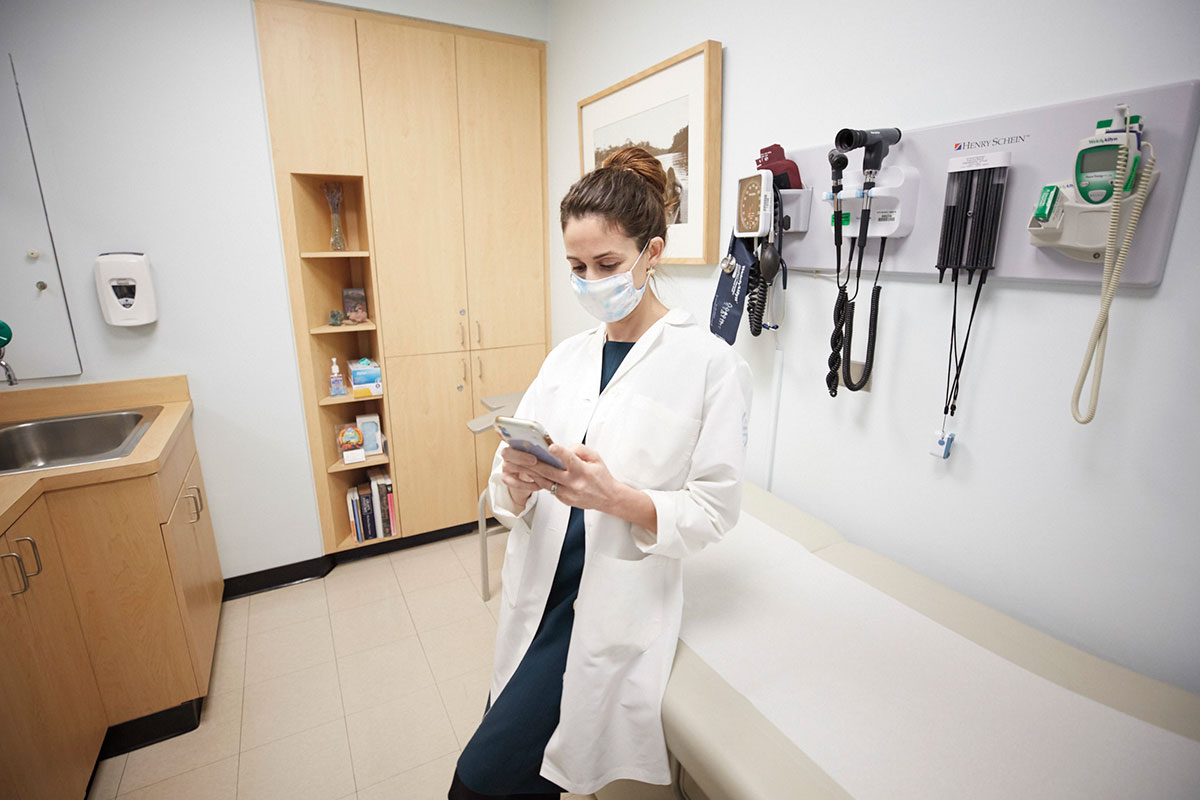Feature
Building a better COVID test
How a small study of arthritis patients gave birth to the pandemic’s most innovative virus test
By Joshua KrischLooking back, vaccine coursing through our veins, it’s easy to forget just how chaotic those early days of the pandemic were. But there was a time when it was hard to even find out if you were sick.
For months, COVID testing was a mess. There were dozens of testing protocols, many of them hastily released and unregulated. Tests themselves were scarce, slow, overpriced, and frequently unreliable. The testing process was risky for those collecting and processing samples. And the disease was spreading at busy testing sites. Testing failures weren’t the only reason the SARS-CoV-2 virus was surging out of control. But they certainly helped.
Robert B. Darnell looked on in horror. “Every aspect of COVID-19 testing fell apart,” he says.
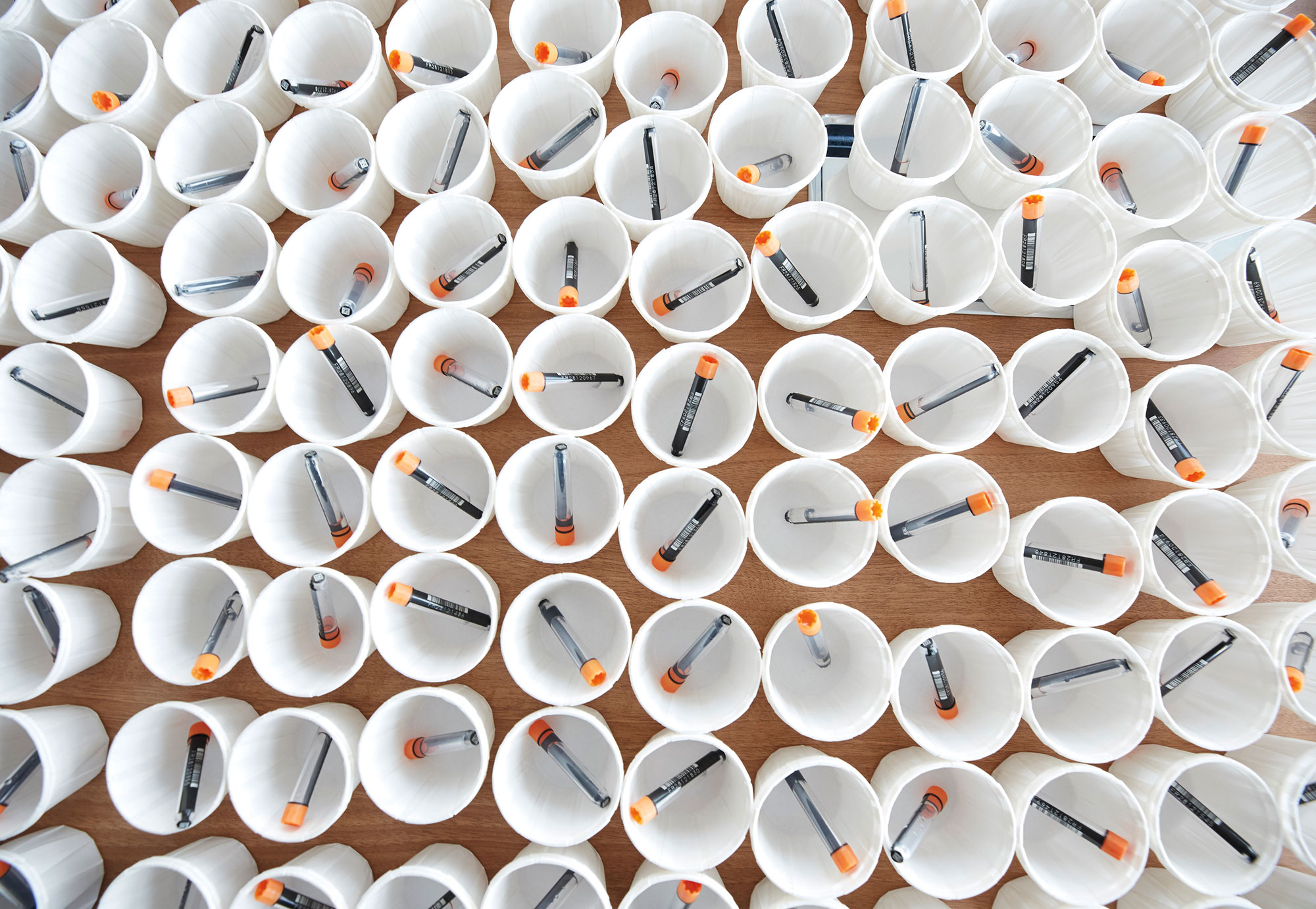
Darnell isn’t a virologist. He’s not an epidemiologist or an expert in infectious disease. Before COVID-19 upended his research, Darnell’s lab was primarily focused on RNA biology and autoimmune inflammatory diseases, in the lab and in the clinic. But thanks to a genetic testing procedure he developed as part of that research, Darnell found himself in the perfect position to take on the COVID clinical testing problem.
In the summer of 2020, the consequences of our failed national testing apparatus were piling up. Doctors were guessing at diagnoses. Hospitals were struggling to isolate infectious patients. Public health officials were unable to track trends and identify hot spots, let alone trace contacts and establish effective quarantine programs. Reopening schools and workplaces was unthinkable.
In a head-to-head comparison with two commercial laboratories, the DRUL assay detected four positive cases that the nasal swab had missed entirely.
Long before the virus struck, Darnell was a proponent of self-tests—the kind you can do at home with a kit and send in the mail. Many patients with autoimmune disorders such as rheumatoid arthritis, which Darnell studies along with his collaborator Dana Orange, an assistant professor of clinical investigation, suffer unpredictable spikes in severity. The researchers had a long-term project to collect patients’ blood samples over time, tracking how levels of certain RNA might change in the days and weeks leading to a flare-up.
Over five years, Darnell’s lab perfected a system by which arthritis patients could prick their fingers at home on a regular basis, collect the blood in a tube containing a solution that stabilizes RNA, and ship it to the lab for analysis. It was an easy, cost-effective way of acquiring samples directly from patients. And, although he didn’t know it at the time, it was a pretty good proof of concept for a community testing scheme.
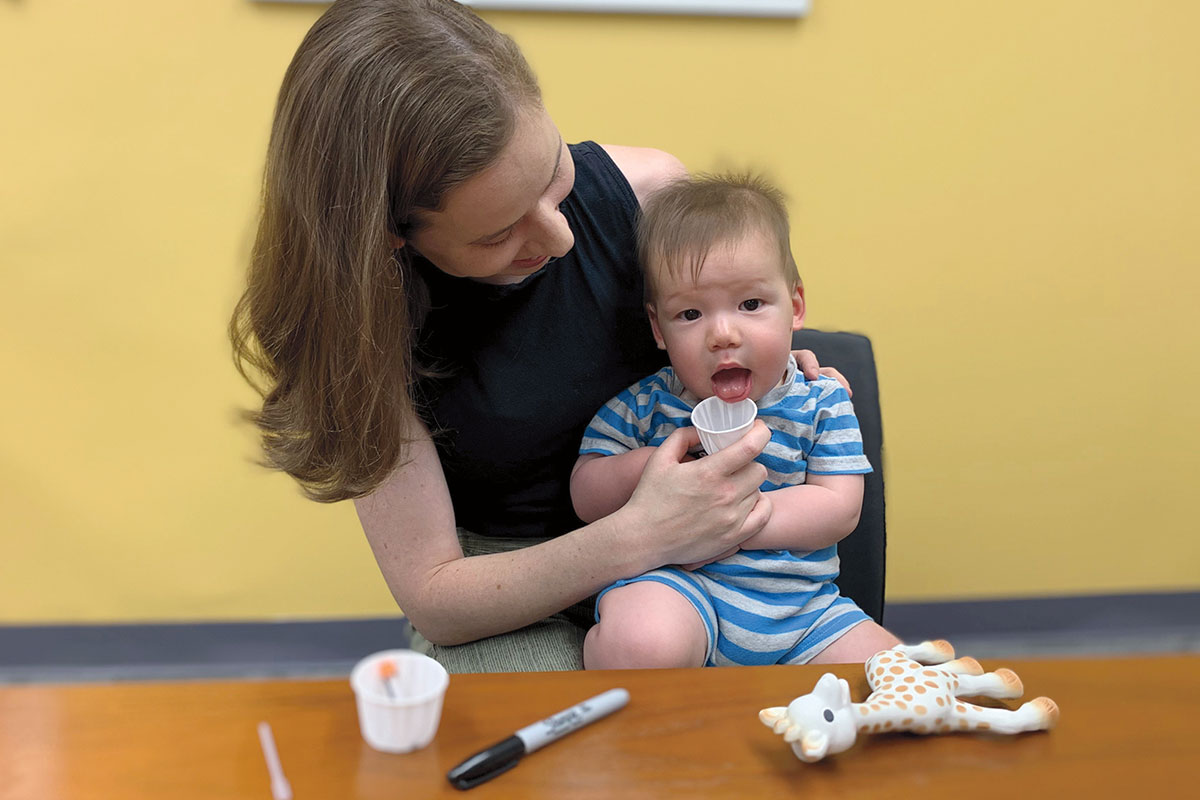
“We had RNA and molecular biology expertise, a distribution system, and an idea for collecting samples from individuals over time,” Darnell says. “Then the novel coronavirus—an RNA virus—blew up.” Suddenly, one of the most pressing needs of biomedicine was for a safe and inexpensive way to collect samples from patients remotely and screen them for viral RNA.
Darnell, who is Robert and Harriet Heilbrunn Professor, hatched a plan to develop a simple COVID test that could be administered easily at home, processed with readily available supplies, and deployed rapidly. The best part: no deep nasal swabs. All you have to do is spit in a cup.
By mid-fall, Darnell’s operation, run from his own Rockefeller lab, had become a well-oiled machine, both technologically advanced and charmingly scrappy. His staff worked alongside newly hired laboratory consultants, graduate students, postdocs, and faculty and administrative staff reassigned from other departments. The sophisticated trappings of a clinical laboratory juxtaposed with a revolving door of Darnell’s colleagues asking questions or lending a hand. Alongside a robotic arm that uncapped vials and mechanically mixed buffers, volunteers stuffed homemade testing kits into plastic baggies.
“It takes a village,” Darnell says. “But we ended up with an extremely sensitive, safe, and inexpensive test that, logistically, could be done at home or in the office.”
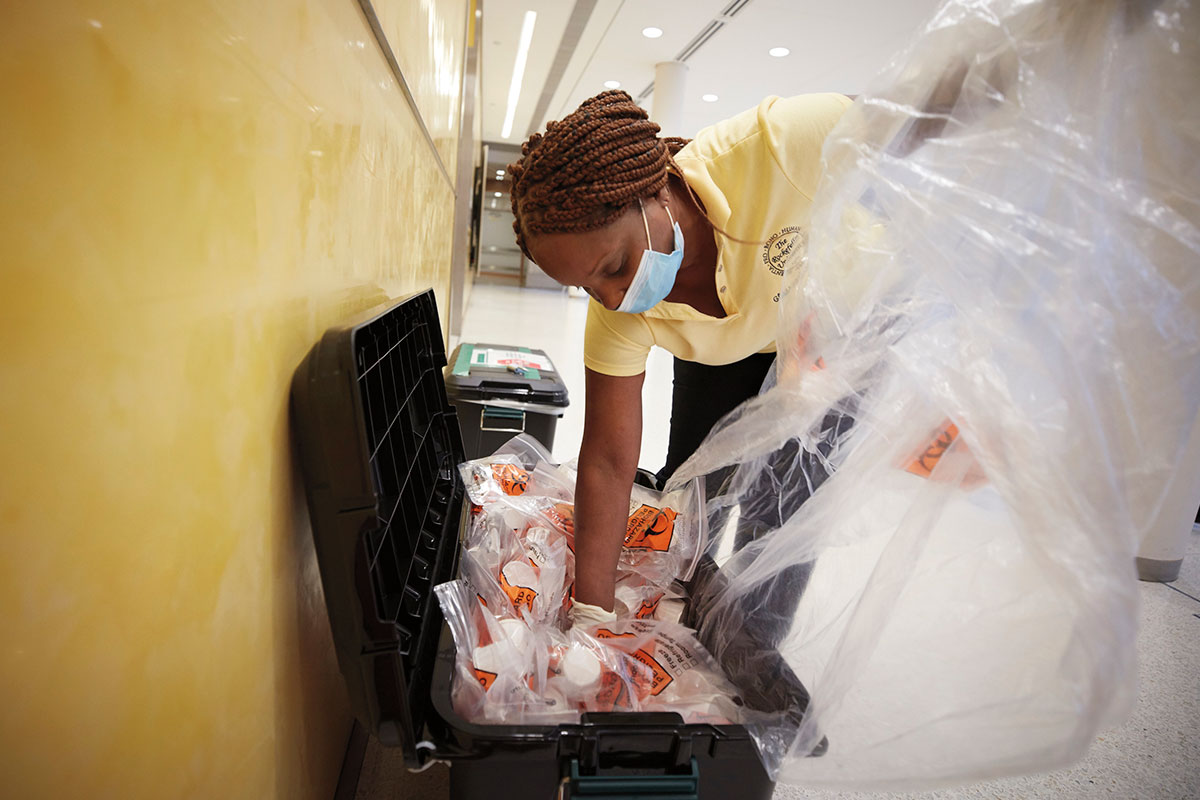
It was clear early on that a saliva-based test was the way to go. Studies from the 2003 SARS pandemic had demonstrated that coronaviruses infect salivary glands quite efficiently, and that whatever traces of virus could be collected by an uncomfortable and occasionally painful half-inch nasal swab could be obtained just as easily by having people spit into a cup.
Indeed, the Hong Kong government adopted a saliva test early on that showed promising results. “Together, these observations piqued our interest in trying to put together a saliva test that could be performed at home, placed in a buffer solution, and easily brought to the lab for analysis,” Darnell says.
Although several groups jumped on the saliva bandwagon, Darnell’s prior work with RNA gave the Rockefeller team an edge. And while many others focused on developing buffer solutions that would culture the virus and keep it alive long enough for testing, Darnell understood that spitting into a solution designed to grow more virus, or even just sending possibly contaminated “raw saliva,” put everyone along the testing pipeline in danger. It was an unnecessary risk—you don’t need live virus to detect the coronavirus’s unique RNA signature.
“We developed a simple buffer, which uses inexpensive off-the-shelf reagents and, instead of culturing the virus, kills it on contact,” Darnell says. “At the same time the solution stabilizes RNA, which is what we need to detect the virus.”
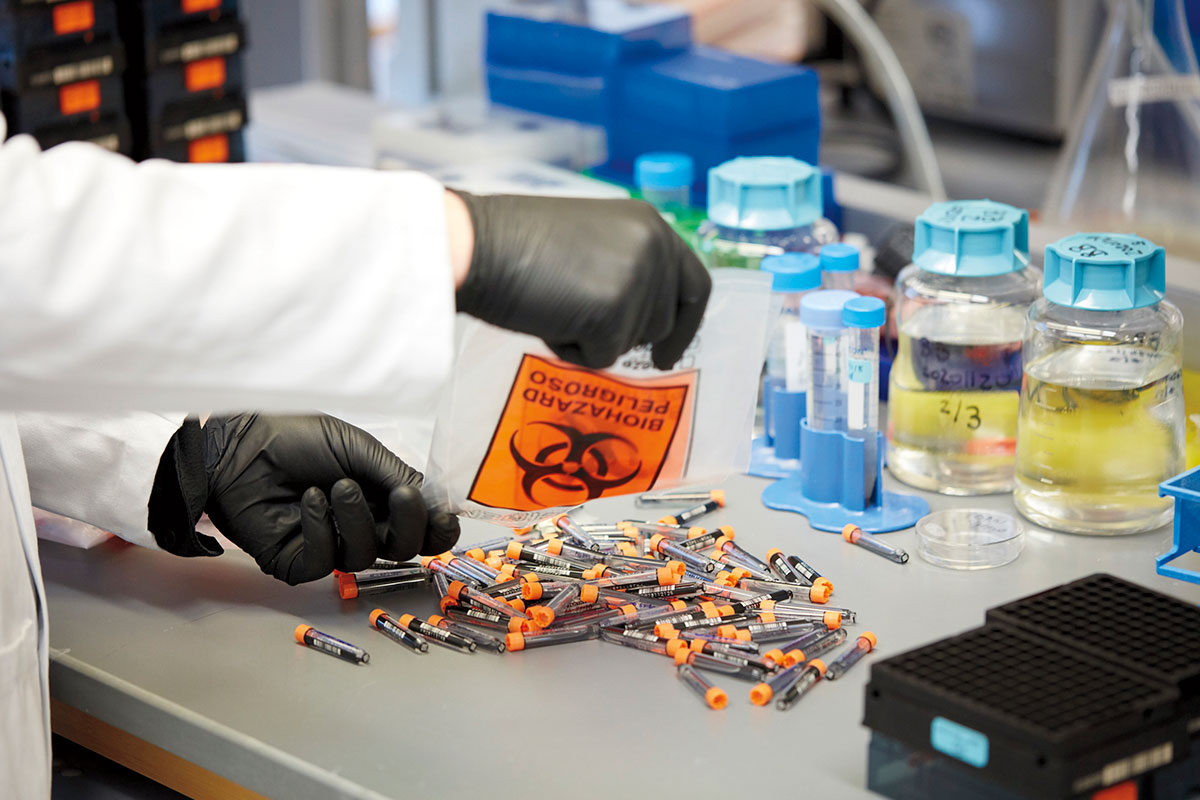
Critically, the use of saliva meant the test could be self-administered. No nurses, no techs, no need for disposable PPE.
“At the time, there were shortages of swabs and gloves and masks and reagents,” says Mayu Frank, clinical research coordinator in Rockefeller’s Clinical Genomics Lab. “Our goal was to get around those obstacles, too, by designing a home collection kit.”
By the time Darnell’s saliva-based home-collection protocol rolled out in April, New York State had clinically certified the lab and green-lighted the test, and preliminary results suggested his assay was at least ten times more sensitive than comparable tests. Practically, this meant that the Darnell test could likely detect much less virus, screening even asymptomatic patients and catching infections earlier on.
Darnell’s test, cleverly dubbed the DRUL (Darnell Rockefeller University Laboratory) saliva assay, soon became the centerpiece of the university’s reopening plan. It circumvented many of the shortages, dangers, and impracticalities of screening for the virus, and by the beginning of 2021, the Darnell lab was processing over 1,500 clinically certified saliva tests each week, ensuring that everyone reporting to work at Rockefeller’s campus could be screened every seven days.
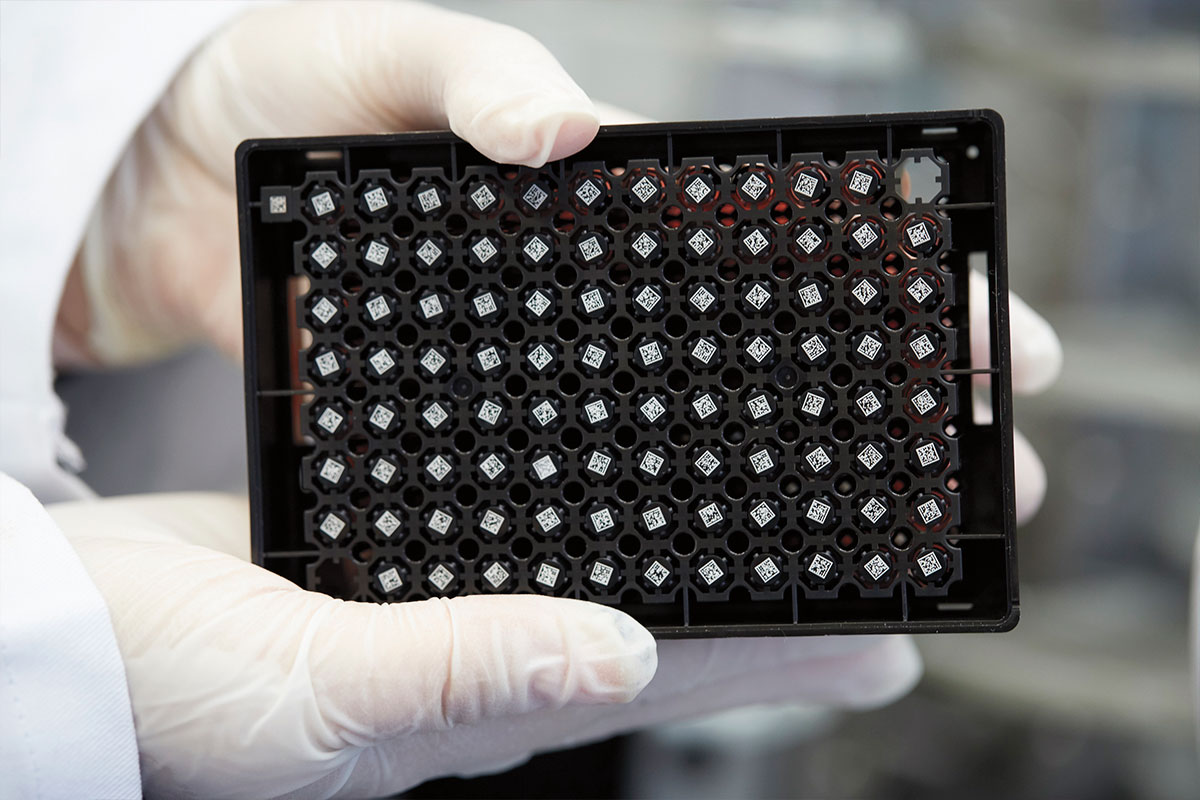
A saliva test at Rockefeller begins its life in the Darnell lab, where members of the team take turns assembling 1,500 homemade kits each week. Every kit contains a barcoded vial of virus-killing, RNA-stabilizing buffer loaded by a robot, together with a biohazard bag, two paper cups, and a small plastic bulb, along with illustrated instructions resembling an airplane emergency evacuation guide.
The instructions are simple: Spit barely one-fiftieth of a teaspoon into the cup, use the bulb to transfer it to the vial, and seal the contents in the biohazard bag. It is also relatively stress-free. Comparable saliva tests, Darnell says, demand as much as an entire teaspoon of saliva—nearly ten minute’s worth. (For more on producing spit, see The lemon aid).
From Darnell’s lab, the kits can be sent anywhere. But most are disseminated around Rockefeller’s campus by staff from the university’s centralized glasswashing facility, which already makes daily rounds to pick up and deliver glassware. Alice Dyer, who runs the service, and her colleagues generally pick up a week’s worth of test kits from the Darnell lab on Mondays and divide the bounty among six red bins placed at strategic locations around campus. Individuals can take a kit from a red bin, self-administer the test, and drop their samples in a corresponding green bin.
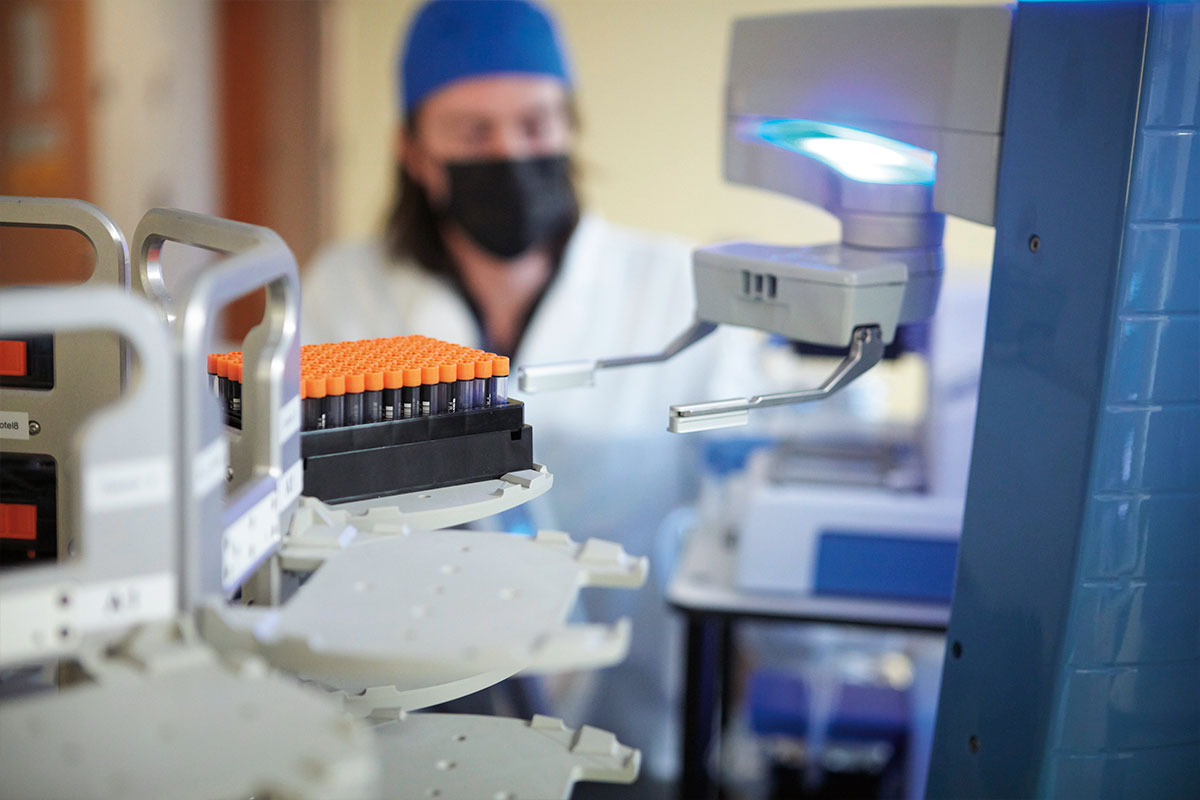
“It is very important that the samples are picked up in a timely manner, so the test can be completed as soon as possible,” says Dyer. “If we did not have this system, we could have a COVID-positive person walking around campus unwittingly infecting other people for days while they wait for their results.”
During the peak of the testing program, between 300 and 400 completed test kits were arriving in the Darnell lab each weekday, courtesy of Dyer’s team. Once received, the entire collection is placed in an oven for ten minutes to sterilize the outside of the kits, thin the saliva for testing, and kill any residual virus. Lab members then load a robotic arm with 96 vials at a time, where the samples are automatically uncapped and mixed with more solutions that prepare the RNA for extraction and PCR analysis.
Samples are finally loaded into a PCR machine, which amplifies the genetic material in the sample, allowing for easy detection of known coronavirus signatures. The results are usually negative, showing only natural saliva RNA. But there are occasional positives. “When it’s positive for viral RNA, it is very clearly positive,” Darnell says. After testing, the samples are destroyed and the results are reported back to the patients as well as to state public health authorities. If a test comes back positive, the university’s nursing staff are notified so that contact tracing can begin.
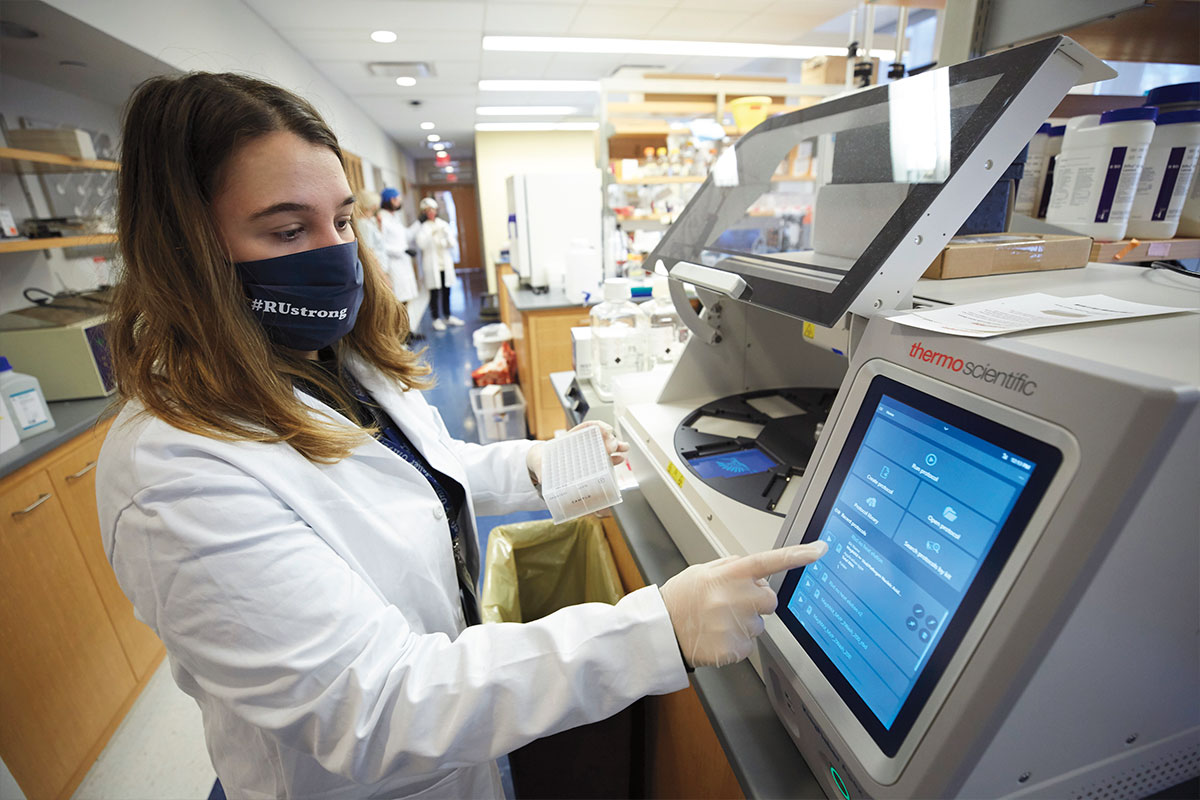
In order for the results to be clinically useful, the Darnell testing lab went through the onerous process of becoming clinically certified, signifying a level of rigor well above that required for research. Work conducted in clinically certified labs requires all members directly involved in the research to undergo training with each assay. Every test must be certified by New York state, and even the most minor upgrades in method or material require fresh approval. A state-licensed clinical director checks in regularly, and the members of the lab are held accountable for their work.
These extra steps mean that the tens of thousands of results processed through the Darnell lab are reported daily to the state and can be studied by health officials and used to track the progress of the pandemic. (Nonclinical research results, by contrast, are considered preliminary and cannot contribute to the development of public health guidelines.)
As part of the test’s validation process, Darnell put it head-to-head against tests processed by two commercial laboratories using protocols operating under the FDA’s emergency use authorization program. Some 162 individuals at two sites received nasal swabs and provided saliva at the same time. In four cases, the DRUL assay detected positive cases that the nasal swab had missed. Overall, the study concluded that Darnell’s test detected the virus as well as—or better—than competing tests.
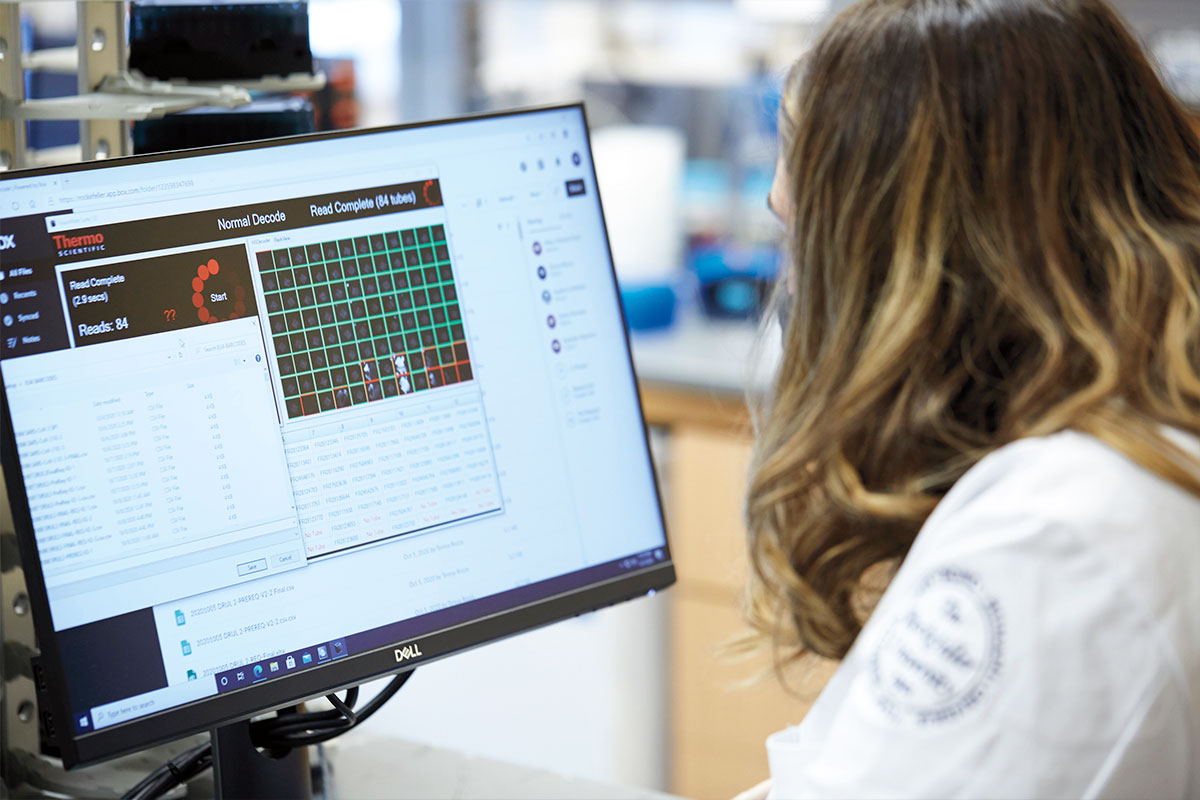
One of the first positive results on campus was a member of the Child and Family Center, which provides childcare and education to families affiliated with Rockefeller. The test had been taken Friday morning, and the results were in that evening.
“We knew immediately,” says Pamela Stark, director of the CFC. With help from OHS and the CFC nurse, the individual’s known contacts were traced and quarantined. By Monday, they were confident the outbreak was contained and no one else was infected.
The program was also critical for the safe continuation of essential operations, such as animal care. Before vaccinations began, the 100 members of Ravi Tolwani’s team at the Comparative Bioscience Center submitted samples for screening each week. When a few positive results turned up in his group, Tolwani collaborated with Darnell to rapidly screen anyone who may have been exposed, and the contagion was contained. “Many of our staff use public transportation, and even though we follow staggered schedules and distancing guidelines, we want CBC members to know that they aren’t spreading the disease to their family members when they go home,” Tolwani says.
Beyond the laboratories, the saliva test has allowed Rockefeller families to return to some degree of normalcy. Thanks to weekly testing of children, teachers, and parents, the CFC reopened in July 2020, months before other schools and childcare programs were able to do the same. Later, testing was expanded to include a K–8 “learning pod” program that provided oversight for small groups of older children attending school remotely. This meant that parents could return to work and that science—including COVID research—could continue. “We have parents who are scientists doing groundbreaking work with COVID-19, but they needed reliable childcare in order to do that work,” Stark says.
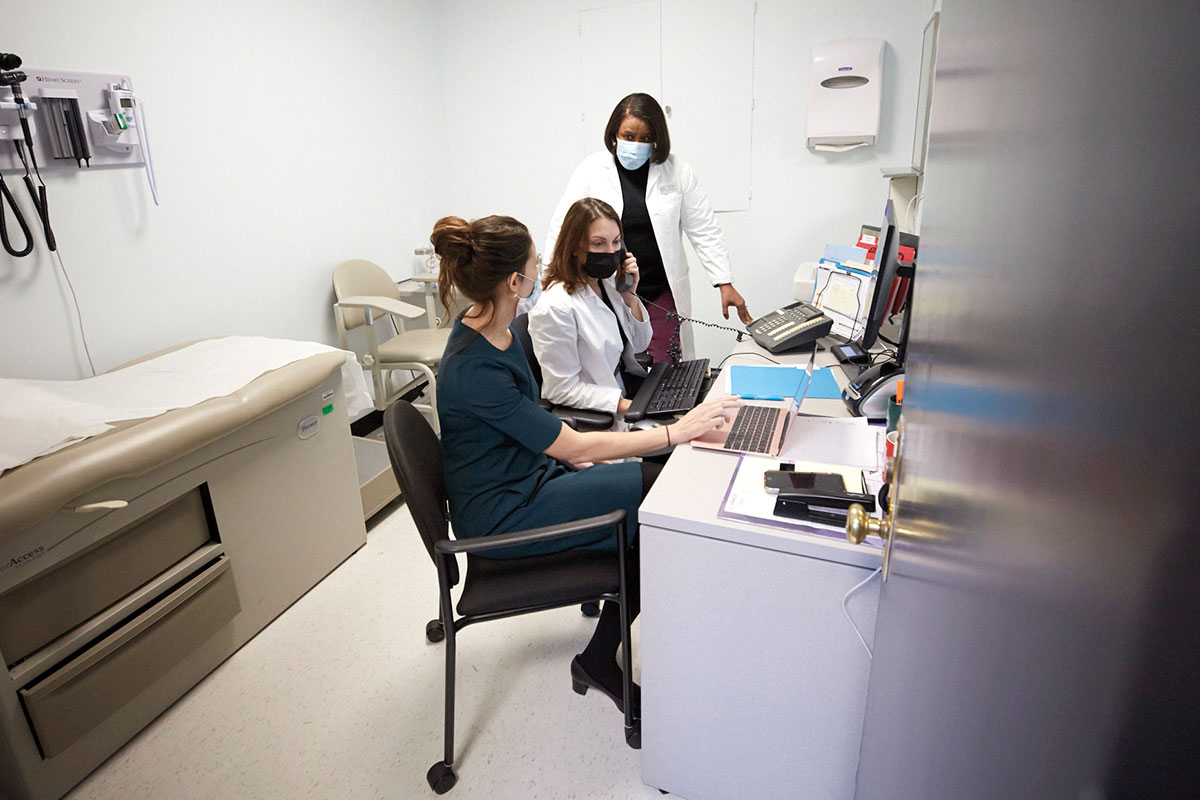
Between March 2020 and May 2021, 150 members of the Rockefeller community tested positive for COVID. There were no deaths and only one hospitalization. Remarkably, no on-campus transmission was detected. Early implementation of Darnell’s testing program, along with rapid quarantining of individuals who tested positive and strict adherence to social distancing, mask wearing, and other infection-control policies, allowed cases to be quickly identified and isolated. The university’s 16-acre campus may well have been the largest chunk of land in the city from which the virus found itself excluded.
Moreover, Rockefeller provided the testing ground for the feasibility of the project and the efficacy of the assay. Darnell’s saliva test has since been distributed far beyond campus.
The technology has been shared with groups at the Howard Hughes Medical Institute research campus, scientists at Stop COVID-19, staff working at New York City’s Department of Health and Economic Development Corporation, and in the city’s integrated health care system. Darnell has also shared his testing protocol with colleagues working in laboratories at the University of Washington, the University of California, Berkeley, Columbia University, Michigan State University, MIT, and the Max Planck Institute.
The team’s daily efforts are still paying off as the pandemic recedes, protecting the Rockefeller community and others. Although high vaccination rates on campus made it possible to relax social distancing policies in the late spring, weekly testing continues, in order to catch both new cases among those who haven’t been fully vaccinated and breakthrough cases in those who have been.
Meanwhile, work to refine the protocol, improve the testing process, and make it more widely accessible continues. When the next virus strikes, the testers will be ready.
